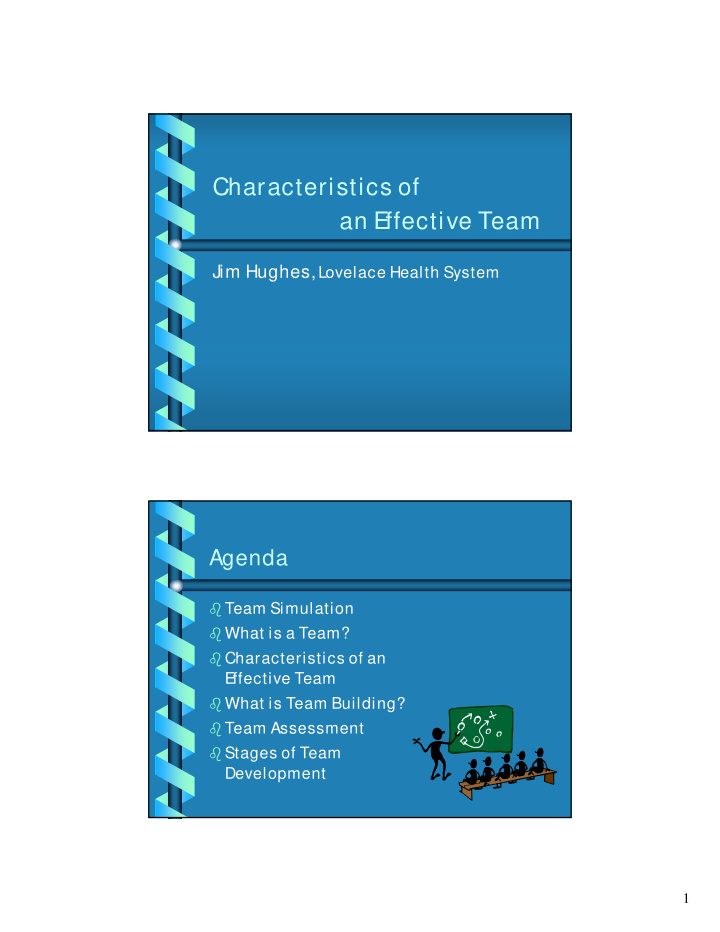



Characteristics of an E ffective Team Jim Hughes, Lovelace Health System Agenda Team Simulation What is a Team? Characteristics of an E ffective Team What is Team Building? Team Assessment Stages of Team Development 1
Activity: Team Simulation Activity: What is a Team? Please find a partner Take 3 minutes to discuss and come up with a definition of a Team Be prepared to share your responses with the group 2
Activity: What is a Team? Here are some terms often used to describe a ‘team’. Co-operation A group of people Serving one customer Whole > Sum Having one aim Working Together Flexibility Synergy Characteristics of E ffective Teams Clear purpose Open 1. 7. communication Informality 2. Clear roles and 8. Participation 3. work Listening 4. Shared leadership 9. Civilized 5. 10. External relations disagreement 11. Style diversity Consensus 6. decisions 12. Self-assessment Parker, G. M., Team Players and Teamwork: The New Competitive Business Strategy (San Francisco: Jossey-Bass, 1990), table 2, p. 33. 3
Clear Purpose The vision, mission, goal, or task of the team has been defined and is now accepted by everyone. There is a plan in place. Informality The climate tends to be informal, comfortable, and relaxed. There are no obvious tensions or signs of boredom. 4
Participation There is much discussion, and everyone is encouraged to participate. E veryone has a say in how things are done. Listening The members use effective listening techniques such as questioning, paraphrasing, and summarizing to get out ideas. 5
Civilized disagreement There is disagreement, but the team is comfortable with this and shows no signs of avoiding, smoothing over, or suppressing conflict. Consensus decisions For important decisions, the goal is substantial - but not necessarily unanimous - agreement through open discussion of everyone’s ideas. 6
Open communication Team members feel free to express their feelings on the tasks as well as on the group’s operation. There are few hidden agendas. Communication takes place outside of meetings. Clear roles and work There are clear expectations about the roles played by each team member. When action assignments are taken, clear assignments are made, accepted, and carried out. Work is fairly distributed among team members. 7
Shared leadership While the team has a formal leader, leadership functions shift from time to time depending on the circumstances, the needs of the group, and the skills of the members. The formal leader models the appropriate behavior and helps establish positive norms. E xternal relations The team spends time developing key outside relationships, mobilizing resources, and building credibility with important players in other parts of the organization. 8
Style diversity The team has a broad spectrum of team- player types including members who emphasize attention to task, goal setting, focus on process, and questions about how the team is functioning. Self-assessment Periodically, the team stops to examine how well it is functioning and what may be interfering with its effectiveness. 9
What is team building? If a team is a group of people working towards a common goal. Team Building is the process of enabling that group of people to reach their goal. What is team building? The major tasks involved in team building are: 1. To clarify the team goals 2. To identify those issues which inhibit the team from reaching their goals 3. To address those issues, remove the inhibitors and enable the goals to be achieved 10
Team Assessment Take a minute and think about the teams you lead or are involved with… Please complete the Team-Assessment Stages of Team Development Tuckman’s Stages of development Norming 11
Stage 1. Forming When teams first get together, members are generally cautious and uncertain about many things. People explore, dabble, try something. During the forming period everyone tries their best to look ahead and think about all the things that need to be done. Leader must set the focus . Stage 2. Storming Inevitably the process begins to heat up under the pressures of work and conflicting perspectives. People jockey for influence. Patient and impatient people clash. Trust is tested, and confusions around goals and roles begin to surface. If there are heavy deadlines, this stage can be quite tense. 12
Stage 3. Norming As people get to know each other, they reconcile and agree on things like decision-making processes, resources, timing, quality standards. A "norm" is something everyone understands. Norms are the formal and informal rules that make up the operating system of productive work. Stage 4. Performing The group is starting to utilize its newly found "norms of trust," and can begin focusing on the tasks to be accomplished; there should be enough drive, creativity, and cohesiveness to take on most tasks. The Team is now really a Team. 13
Stage 5. Adjourning The final stages of team development; it has been an experience of sharing and growing with each other and now members may separate. For many, the group has been a safety net and truly has become their community. Evaluation is key at this stage. Document and Learn from the experience. Review and E valuation What was your main “take-away” from today’s workshop? Take a few minutes to complete the workshop evaluation 14
Conclusion “Teamwork is the ability “Teamwork is the ability to work together to work together toward a toward a comm common vision. The ability to on vision. The ability to direct individu direct individual accomplishments al accomplishments toward organiza toward organizati tional objecti onal objectives es. It . It is is the fuel the fuel that allows that allows commo common peop n people to to attain uncommon results. “ attain uncommon results. “ Unknown Author Unknown Author Thank You! Jim Hughes Director of Organizational Development Lovelace Health System 15
Recommend
More recommend